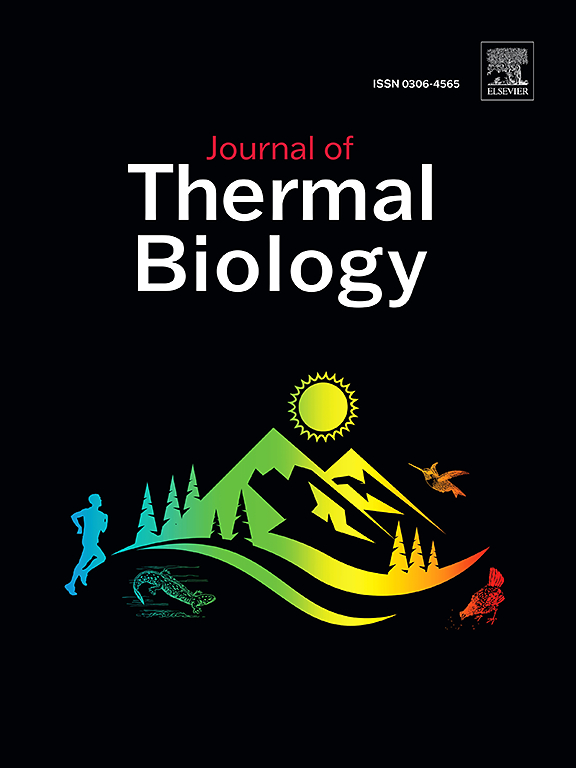Legs are primary heat exchangers in nest-bound White storks
IF 2.9
2区 生物学
Q2 BIOLOGY
引用次数: 0
Abstract
Endotherms must manage heat fluxes under changing environmental conditions to maintain safe core body temperatures. An important mechanism for energy management is peripheral heterothermy. Despite growing evidence that birds’ bare body parts such as legs and bills can serve as effective thermal windows (i.e. areas of controlled heat loss), the function and importance of such body regions likely differ across species and ecological contexts. This might be particularly important for birds breeding in exposed locations (such as open nests) that promote rapid heat gain and loss. Combining thermal imaging with weather data we assess the thermoregulatory role of various body parts (eye region, bill, gular skin, and legs) in White storks (Ciconia ciconia) breeding in Southwestern Iberia. In doing so, we also test whether adults and nestlings differ in their capacity to modulate surface temperature (Tsurf) through these regions across a wide range of environmental temperatures (Tair = 15–38 °C). Our analyses showed that White storks finely tuned Tsurf of all the regions tested in response to Tair, with nestlings showing an overall poorer capacity to modulate Tsurf under colder conditions (Tair < 20 °C). Notably, only the legs served as effective thermal windows in adult storks, with dry heat loss through these appendages representing up to 70 % of basal metabolic rate. Thus, passive heat exchange through the legs can significantly contribute to alleviate heat stress in nest-bound White storks. Yet, further work is needed to better understand the ontogeny of thermal windows in the face of climate change.
白鹳的腿是主要的热交换器
恒温动物必须在不断变化的环境条件下控制热通量,以维持安全的核心体温。能量管理的一个重要机制是外周异热。尽管越来越多的证据表明,鸟类的裸露身体部位,如腿和喙,可以作为有效的热窗(即控制热量损失的区域),但这些身体区域的功能和重要性可能因物种和生态环境而异。这对于在暴露的地方(如开放的巢穴)繁殖的鸟类来说可能尤其重要,因为这些地方会促进热量的快速获得和损失。结合热成像和天气数据,我们评估了伊比利亚西南部白鹳(Ciconia Ciconia)繁殖中不同身体部位(眼睛区域、喙、正常皮肤和腿)的温度调节作用。在此过程中,我们还测试了成虫和雏鸟在大范围环境温度(Tair = 15-38°C)下通过这些区域调节表面温度(Tsurf)的能力是否存在差异。我们的分析表明,白鹳对所有测试区域的Tair都进行了微调,雏鸟在较冷的条件下调节Tair的能力总体较差(Tair <;20°C)。值得注意的是,在成年鹳中,只有腿是有效的热窗,通过这些附体的干热损失占基础代谢率的70%。因此,通过腿部进行被动换热可以显著缓解白鹳的热应激。然而,面对气候变化,需要进一步的工作来更好地了解热窗的个体发生。
本文章由计算机程序翻译,如有差异,请以英文原文为准。
求助全文
约1分钟内获得全文
求助全文
来源期刊

Journal of thermal biology
生物-动物学
CiteScore
5.30
自引率
7.40%
发文量
196
审稿时长
14.5 weeks
期刊介绍:
The Journal of Thermal Biology publishes articles that advance our knowledge on the ways and mechanisms through which temperature affects man and animals. This includes studies of their responses to these effects and on the ecological consequences. Directly relevant to this theme are:
• The mechanisms of thermal limitation, heat and cold injury, and the resistance of organisms to extremes of temperature
• The mechanisms involved in acclimation, acclimatization and evolutionary adaptation to temperature
• Mechanisms underlying the patterns of hibernation, torpor, dormancy, aestivation and diapause
• Effects of temperature on reproduction and development, growth, ageing and life-span
• Studies on modelling heat transfer between organisms and their environment
• The contributions of temperature to effects of climate change on animal species and man
• Studies of conservation biology and physiology related to temperature
• Behavioural and physiological regulation of body temperature including its pathophysiology and fever
• Medical applications of hypo- and hyperthermia
Article types:
• Original articles
• Review articles
 求助内容:
求助内容: 应助结果提醒方式:
应助结果提醒方式:


